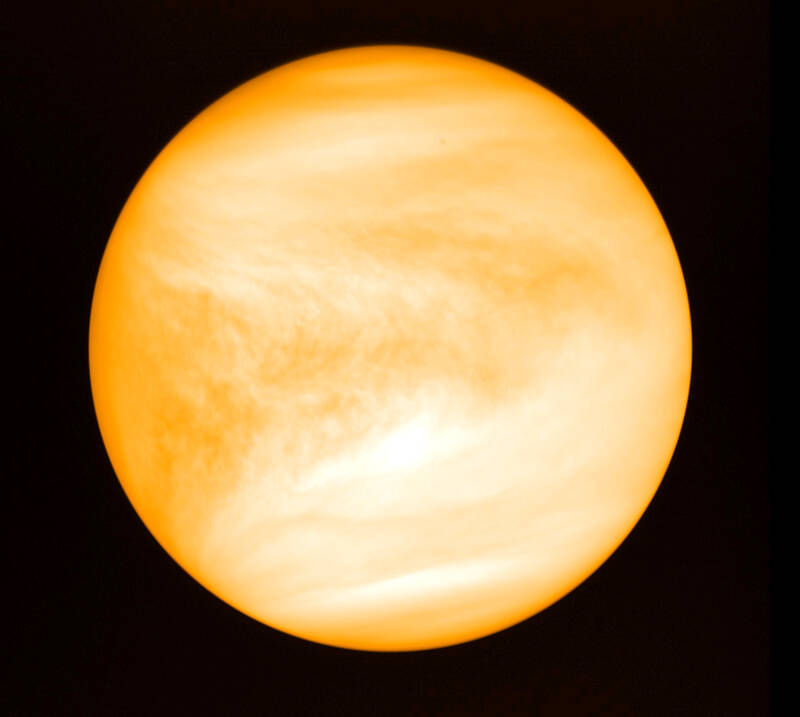A Soviet-era spacecraft plunged to Earth on Saturday, more than a half-century after its failed launch to Venus.
Its uncontrolled entry was confirmed by both the Russian Space Agency and EU Space Surveillance and Tracking. The Russians indicated it came down over the Indian Ocean, but some experts were not so sure of the precise location. The European Space Agency’s space debris office also tracked the spacecraft’s doom after it failed to appear over a German radar station.
It was not immediately known how much, if any, of the half-tonne spacecraft survived the fiery descent from orbit. Experts said ahead of time that some, if not all of it, might come crashing down, given it was built to withstand a landing on Venus, the solar system’s hottest planet.

Photo: JAXA via AP
The chances of anyone getting clobbered by spacecraft debris were exceedingly low, scientists said.
Launched in 1972 by the Soviet Union, the spacecraft known as Kosmos 482 was part of a series of missions bound for Venus. However, this one never made it out of orbit around Earth, stranded there by a rocket malfunction.
Much of the spacecraft came tumbling back to Earth within a decade of the failed launch. No longer able to resist gravity’s tug as its orbit dwindled, the spherical lander — an estimated 1m across — was the last part of the spacecraft to come down. The lander was encased in titanium, according to experts, and weighed more than 495kg.
Any surviving wreckage would belong to Russia under a UN treaty.
Following the spacecraft’s downward spiral, scientists, military experts and others could not pinpoint in advance precisely when or where the spacecraft might come down. Solar activity added to the uncertainty as well as the spacecraft’s deteriorating condition after so long in space.
After so much anticipation, some observers were disappointed by the lingering uncertainty over the exact whereabouts of the spacecraft’s grave.
“If it was over the Indian Ocean, only the whales saw it,” Dutch scientist Marco Langbroek said wrote on X.
As of Saturday afternoon, the US Space Command had yet to confirm the spacecraft’s demise as it collected and analyzed data from orbit.
The US Space Command routinely monitors dozens of reentries each month. What set Kosmos 482 apart — and earned it extra attention from government and private space trackers — was that it was more likely to survive re-entry, according to officials.
It was also coming in uncontrolled, without any intervention by flight controllers who normally target the Pacific and other vast expanses of water for old satellites and other space debris.

BOMBARDMENT: Moscow sent more than 440 drones and 32 missiles, Volodymyr Zelenskiy said, in ‘one of the most terrifying strikes’ on the capital in recent months A nighttime Russian missile and drone bombardment of Ukraine killed at least 15 people and injured 116 while they slept in their homes, local officials said yesterday, with the main barrage centering on the capital, Kyiv. Kyiv City Military Administration head Tymur Tkachenko said 14 people were killed and 99 were injured as explosions echoed across the city for hours during the night. The bombardment demolished a nine-story residential building, destroying dozens of apartments. Emergency workers were at the scene to rescue people from under the rubble. Russia flung more than 440 drones and 32 missiles at Ukraine, Ukrainian President Volodymyr Zelenskiy

‘SHORTSIGHTED’: Using aid as leverage is punitive, would not be regarded well among Pacific Island nations and would further open the door for China, an academic said New Zealand has suspended millions of dollars in budget funding to the Cook Islands, it said yesterday, as the relationship between the two constitutionally linked countries continues to deteriorate amid the island group’s deepening ties with China. A spokesperson for New Zealand Minister of Foreign Affairs Winston Peters said in a statement that New Zealand early this month decided to suspend payment of NZ$18.2 million (US$11 million) in core sector support funding for this year and next year as it “relies on a high trust bilateral relationship.” New Zealand and Australia have become increasingly cautious about China’s growing presence in the Pacific

Indonesia’s Mount Lewotobi Laki-Laki yesterday erupted again with giant ash and smoke plumes after forcing evacuations of villages and flight cancelations, including to and from the resort island of Bali. Several eruptions sent ash up to 5km into the sky on Tuesday evening to yesterday afternoon. An eruption on Tuesday afternoon sent thick, gray clouds 10km into the sky that expanded into a mushroom-shaped ash cloud visible as much as 150km kilometers away. The eruption alert was raised on Tuesday to the highest level and the danger zone where people are recommended to leave was expanded to 8km from the crater. Officers also

ESPIONAGE: The British government’s decision on the proposed embassy hinges on the security of underground data cables, a former diplomat has said A US intervention over China’s proposed new embassy in London has thrown a potential resolution “up in the air,” campaigners have said, amid concerns over the site’s proximity to a sensitive hub of critical communication cables. The furor over a new “super-embassy” on the edge of London’s financial district was reignited last week when the White House said it was “deeply concerned” over potential Chinese access to “the sensitive communications of one of our closest allies.” The Dutch parliament has also raised concerns about Beijing’s ideal location of Royal Mint Court, on the edge of the City of London, which has so